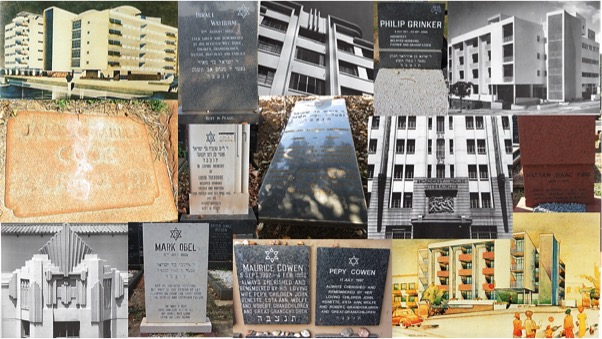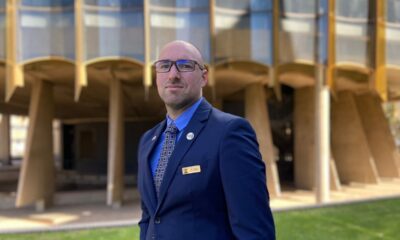
Lifestyle

Joburg – city of architects and dreamers
In spite of its reputation for being the “engine room” of the country, Johannesburg has many elegant, experimental buildings designed by Jewish architects.
Johannesburg Heritage Foundation’s Flo Bird and Brian McKechnie recently took viewers on a virtual tour of many of these buildings, downtown and uptown. Some of them have fallen into disrepair, but they are still a testament to innovation, and continue to contribute to the lives of those who live and work in them.
The tour, unusually, linked the buildings to their creators’ graves at Westpark Cemetery, with epitaphs contributing to our understanding of who they were.
“This tour was inspired by encountering the graves of architects whose work I loved,” Bird said, pointing out that a virtual tour allows us to traverse the large Westpark Jewish Cemetery with ease.
It started with Morrie (MJ) Jacob, who died in 1950. Jacob designed the Doornfontein Synagogue (1905) otherwise known as the Lions Shul, named for the bronze lions on either side of the stairs. In its day, Doornfontein was a desirable address for Jews. Though today the shul is squashed up against Joe Slovo Drive with an ugly fence, it’s still loved for its beauty and unusual touches like minarets, stone columns, and basilica-like space.
Another one of Jacob’s buildings, Cohn’s Pharmacy in Pageview (1906), is an example of the city’s obsession with corner buildings, which tended to be far more elegant and accentuated than those in the middle of the block. Jacob’s Jewish Guild War Memorial building in the old city centre (1922/23) is a pile of an Edwardian building which also celebrates its corner status.
Israel Wayburne (1983) is known, among other things, for employing famous activist and communist Rusty Bernstein. He’s responsible for a number of the maisonette flats (two down, two up) in Yeoville.
“Each building contributes to an interesting and varied landscape [compared, say, to monotonous Fourways],” said Bird.
One of his most well-known buildings is, in fact, the ohel at Westpark, which has a religious and aesthetic function (in spite of an unsightly drainpipe addition at the front). “Luckily Issie doesn’t have to see it as his grave is on the other side of the building,” Bird commented.
Louis Theodore Obel (1956), who was in partnership with his brother, Mark, was a graduate of the University of the Witwatersrand (Wits) – as were many of the architects mentioned. Obel and Obel made a great contribution to art deco architecture, including the Barbican Building (1930), which was the tallest building in Johannesburg at the time, Astor Mansions, one of Joburg’s first skyscrapers, and Beacon Royale flats (1934), at the bottom of Yeoville on Louis Botha Avenue.
Maurice Cowen (1990) contributed to the decorative facades of many of Joburg’s best-known schools, including Parktown Girls and Jeppe Boys, and the panels gracing 1930s-era Dunvegan Chambers, Roehampton Court, Shakespeare House, and Broadcast House in the Johannesburg CBD. The latter was the original home of the South African Broadcasting Corporation. The crazy antennae designed for the top of this building didn’t have any real function, McKechnie said, though it copied the antennae on top of the BBC, and there was briefly the idea of using it to dock airships.
Another Wits graduate, Leopold Grinker (1973), was an anti-establishment figure who disliked modernism. Grinker’s Normandie Court (1937) in Delvers Street, Newtown, combines art deco with his obsession with the streamlined form of ships. So too does Daventry Court in Killarney (also built in the 1930s), which was Killarney’s first modern block of flats.
Harold Leroith (also a Wits’ alma mater) is best known for designing Temple Emanuel in Parktown (1954). This minimalist, modern building has concrete recesses which make it sculptural and provide shade for its windows. It also shows concern for materials like stone and face brick.
Leroith also designed Redoma Court, which architects consider one of Johannesburg’s best buildings, and the iconic, shiplike San Remo (1937) Both are sadly in a dilapidated state in Yeoville.
Monty Sack, an architect and artist and another Wits graduate, (2009), incorporated the work of artists in Killarney Hills built on top of Killarney Ridge, built to house actors for the studio of American financier Isidore Schlesinger.
Sidney Abramowitch (2016) passionately lobbied to save Joburg’s historical buildings such as the Markham Building, and is known for designing Innes Chambers in 1963, now used by the National Prosecuting Authority. This unusual building with Y-shaped columns representing the scales of justice, was covered with mosaics, which recently had to be painstakingly restored.
Lastly, the tour touched on the work of Gerald Gordon (2016), also a Wits graduate, who the group described as “an outstanding brain who was unable to limit himself to any single factor”. Gordon, who incubated many of South Africa’s best-known architects in his many years of lecturing at Wits, is best known for designing mountain houses on Linksfield Ridge, such as 7 New Mountain Road (early 70s), which literally cling to the edges of cliffs.
He’s also known for developing a new construction method he named “thin-skin architecture” which uses no bricks and is extremely strong because of its monocoque construction (a type of construction used in cars and aeroplanes).
Like many others, the brilliance and bravery of these Jewish architects leaves a legacy that can’t be eradicated.










